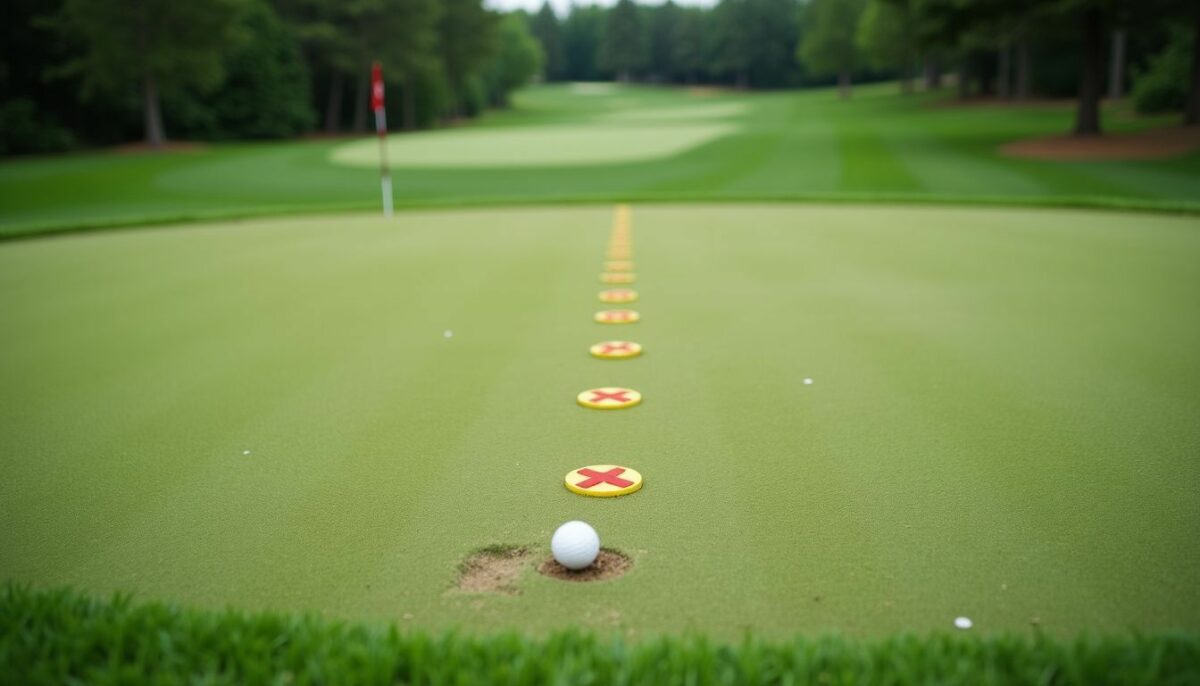Feeling out of place on a golf course can be tough for beginners. Golf etiquette basics are just as important as knowing how to swing a club. This guide will help you avoid rookie mistakes and fit right in with seasoned players.
Stick around—it’s easier than you think!
Key Takeaways
- Arrive 30 minutes early, warm up properly, and stay prepared to respect others’ time.
- Follow the dress code: wear collared shirts, proper shoes, and avoid casual outfits like jeans or T-shirts.
- Respect silence during swings, avoid distractions, and stand in safe positions to maintain focus.
- Repair divots and ball marks immediately to keep the course tidy for all players.
- Let faster groups play through if you’re behind to ensure smooth gameplay for everyone.
Arrive Early and Be Prepared

Arriving 30 minutes before tee time sets the tone for the day. Start with your short irons to loosen up, then work through mid and long irons. Finish warm-ups by swinging woods. Save energy—avoid hitting too many balls.
Wrap it up with soft wedge shots and a few putts on the practice green.
A slow start can rattle even seasoned players, so being early shows respect for others in your group and helps prevent delays. Preparation keeps the game flowing smoothly, aligning well with golf traditions of punctuality and readiness.
“The more you sweat in practice, the less you bleed in battle.”
Ready to look sharp? Let’s talk dress code next!
Dress Code: Follow Course Guidelines
Collared shirts and well-fitted shorts or slacks are course staples. Most golf courses adhere to these dress codes, so leaving T-shirts and gym clothes at home shows respect. Golf shoes with soft spikes provide grip without harming the greens.
Avoid jeans, cargo shorts, or anything overly casual. Clubs encourage players to appear refined while honoring tradition. Dress appropriately to align with fellow golfers and professional golfers alike—it’s part of the game’s appeal.
Respect the Quiet Zone

Talking during someone’s swing can break focus faster than a cracked putter. Golfers need silence to concentrate, so keep chatter at bay while others take their shots. Step aside and stay out of the line of sight.
Standing behind or too close might feel like lurking, which no one appreciates on the fairways.
Position yourself safely to the side, far enough not to distract but close enough for your turn. Avoid rustling bags or fiddling with golf clubs mid-swing—it’s as bad as shouting “Fore!” in a library.
Respecting quiet zones shows consideration and keeps nerves from fraying before hitting birdies and eagles.
Next up: learn how keeping up pace avoids slow play!
Keep Up the Pace of Play

Slow play can ruin the mood for everyone. Golfers should aim to hit their shots within 30-45 seconds of reaching the ball. This includes choosing a golf club and setting up your stance.
If someone isn’t ready, others in the group may hit first—this is called “ready golf.”.
A lost ball search now has a strict limit of three minutes since 2019. Sticking to this rule helps avoid delays on the course. Faster groups should be allowed to play through if lagging behind.
Keeping things moving ensures smooth gameplay for all golfers without frustration or meltdowns.
Golf flows like water; slow it down too much, and it becomes a dam.
Know Where to Stand on the Tee and Green

Every golfer should know where to stand during a game. This keeps everyone safe and avoids distractions.
- Stand to the side of someone taking a shot, not behind them. This gives them space and helps avoid accidents.
- Keep a safe distance from the player swinging their club. Standing too close can lead to injuries.
- On the putting green, stay off other players’ putting lines. Stepping on these lines can ruin their shot accuracy.
- Stay visible but out of the player’s direct line of sight when they are aiming or swinging.
- Avoid casting shadows over the ball or cup on the putting green. Shadows can distract golfers as they focus on their shots.
- Watch your feet position to avoid stepping on repaired ball marks or divots near the teeing area or green.
- Move quietly while players prepare their shots, as noise can ruin concentration for many golfers.
- Pay attention to etiquette signs posted at some courses that indicate standing zones around tees and greens.
Repair Ball Marks and Replace Divots

A well-kept course makes the game enjoyable for everyone. Caring for the greens and fairways shows respect for other golfers and golf traditions.
- Fix ball marks on the green quickly. Use tools like a tee, key, knife, or repair tool to reshape the grass gently. Avoid prying up the soil as it can damage the roots.
- Know about common pitch marks. Flatten “The Bruise” by pressing edges back into place. Smoothen “The Dent” carefully to level it out. Fill in gaps from “The Pit” with available seed mix if needed. Treat long scrapes like “The Skid Mark” with extra care to prevent further tearing.
- Replace divots on fairways immediately after hitting your shot. Pick up any loose turf pieces and fit them back like puzzle pieces.
- Use soil or seed mixtures provided by the course if divots are too damaged to replace directly.
- Avoid leaving bare patches behind after repairing or replacing divots; they can slow germinate growth of new grass and ruin the playing surface.
- Carry small tools in your golf bag at all times—this helps you act fast without holding others up.
- Be mindful while repairing during peak play hours so as not to cause bottlenecks that lead to slow play for groups following behind.
- Make it a habit after every shot to check for visible damage caused by your swing trajectory across greens or rough edges from mishits on turf spaces along lines of sight across major putting zones nearby adjacent greens paths
Rake the Bunker After Use

A clean bunker shows respect for others on the course. Leaving it messy can ruin the game for the next player.
- Always rake the sand after hitting a shot from a bunker. This avoids uneven surfaces or pits that could trap another golf ball.
- Place the rake in or near the bunker once finished. Golf courses prefer this to keep things tidy and safe.
- Smooth out footprints, divots, or other marks left behind while you played your shot.
- Keep strokes clean to avoid leaving deep ridges behind in the sand.
- Stay mindful of pace of play while raking, but don’t rush and leave poor results.
- Use both hands on the rake for better control and even distribution of sand.
- Push and pull gently over affected areas until they look flat again. No one wants unfair bumps during their turn!
Let Faster Groups Play Through
Letting faster groups play through shows respect and keeps the pace of play steady. Golfers falling behind should step aside, especially if they’re searching for a lost ball or taking more than 30-45 seconds per shot.
The USGA recommends only three minutes to search for a lost ball to avoid delays.
Slower players can move to the side while others hit through, then continue their game without pressure. This saves time for everyone and maintains harmony on the course. Ignoring this golf etiquette disrupts flow and frustrates other golfers waiting behind—a rookie mistake best avoided!
Avoid Standing or Walking on Putting Lines
Cutting through the green to speed up won’t score points with fellow golfers. Stepping on another player’s putting line can affect their shot. The weight of golf shoes compacts the grass, which changes how a ball rolls.
Always walk around or step over these lines.
Use a coin or small marker to mark your ball if it’s in someone’s path. This signals others and keeps play smooth. Respect for the putting etiquette shows you value the game and others’ experience as well.
Handle the Flagstick with Care
Lift the flagstick gently to avoid scratching the edges of the hole. Dropping it or tossing it aside can damage the cup, ruining putting for others.
Place the flagstick back into its spot carefully after finishing. A crooked or poorly placed stick may slow play and disrupt ready golf. Treat it as part of proper putting etiquette to keep things smooth for everyone.
Use Golf Carts Responsibly
Golf carts deserve the same care as any golf club or putting line. Avoid driving too close to greens, tee boxes, or wet areas. These spots are fragile and can get damaged easily. Stay on marked paths whenever possible.
Signs are there for a reason—follow them.
Don’t treat the cart like a race car. Sudden stops or sharp turns can tear up grass or spill belongings. Keep pace with your group but never rush recklessly across fairways. Thoughtful use shows respect for both the course and others playing alongside you.
Yell “Fore!” When Necessary
A stray shot can happen to anyone, even professionals. Shout “Fore!” loud enough to warn players or nearby groups of a ball heading their way. It’s not just polite; it could prevent serious injuries.
Avoid hesitating if the ball seems out of bounds or veering toward someone. Yelling early gives others more time to react. Always prioritize safety over embarrassment, and never assume people see the danger coming.
Limit Cell Phone Use on the Course
Shouting “Fore!” gets attention on the golf course. Phones, however, do the opposite. Excessive phone use distracts others and disrupts the flow of play. Keeping up a good pace is part of proper golf etiquette.
Use phones only if absolutely needed—like for emergencies or checking time. Texting or answering calls should be done away from tee boxes and greens to avoid disturbing players’ swings and putting lines.
Keep it simple: focus on your game, not your screen!
End the Game with Respect: Shake Hands and Remove Hats
Shake hands with every player at the end of the round. It’s a classic golf tradition that shows good sportsmanship. Remove your hat as a sign of respect while doing so. Thank your group for their time and congratulate those who played well.
Some golfers like to take this moment further by offering drinks or refreshments, especially to caddies who helped during the game. Small gestures, like these, help build camaraderie on the course.
Always leave with grace, whether you scored an eagle or had trouble keeping up with the pace of play!
Conclusion
Golf is more than just a game; it’s about respect and tradition. Following proper etiquette helps beginners blend in and enjoy the experience fully. Small efforts, like fixing ball marks or keeping quiet, go a long way.
Play responsibly, stay mindful of others, and have fun along the way!
FAQs
1. What are the basic rules of golf etiquette every beginner should know?
Always respect the pace of play and avoid slow play. Replace divots, repair ball marks, and fix pitch marks on the green. Stay quiet when others swing or putt, and never walk on someone’s putting line.
2. How can I avoid slowing down the game for others?
Play ready golf to keep things moving. If you lose a ball, hit a provisional ball instead of holding everyone up searching. Be mindful of your group’s pace compared to those ahead and behind you.
3. Are there specific rules for using golf carts?
Yes, follow posted golf cart rules at all times. Stick to paths where required, avoid wet areas, and don’t drive too close to greens or tee boxes.
4. Why is repairing pitch marks important in golf traditions?
Fixing pitch marks shows respect for the course and other players. Unrepaired damage affects putting lines and ruins greens over time.
5. What should I do if I’m unsure about a rule during play?
Ask someone in your group or refer to the rules of golf guidebook later if needed—but keep playing so you don’t hold up others!

